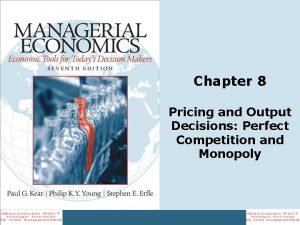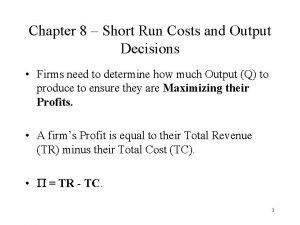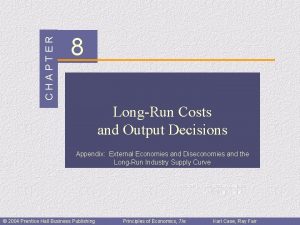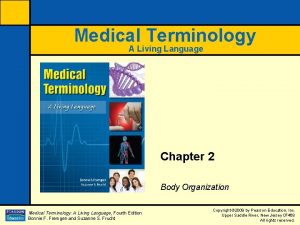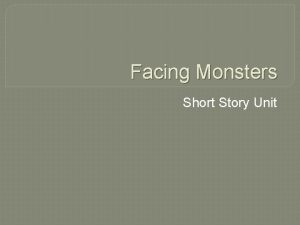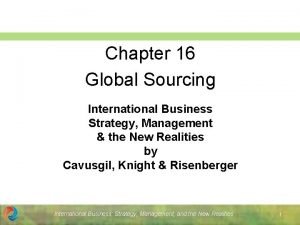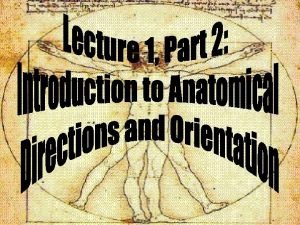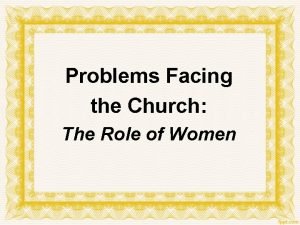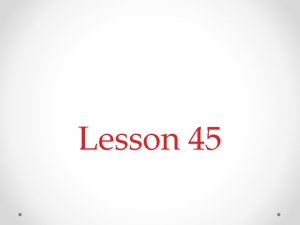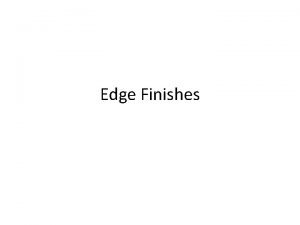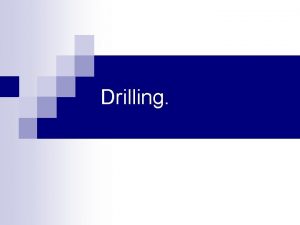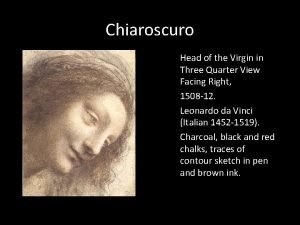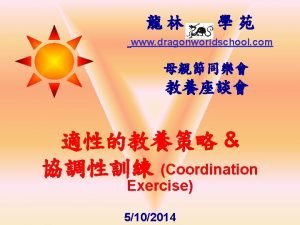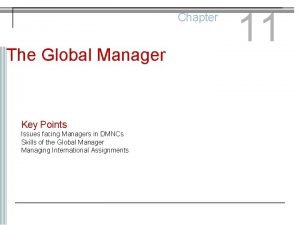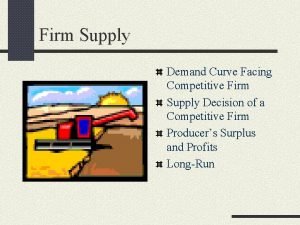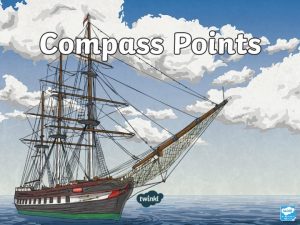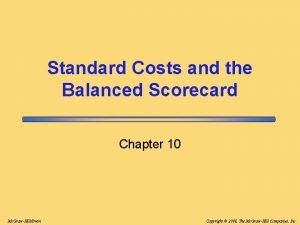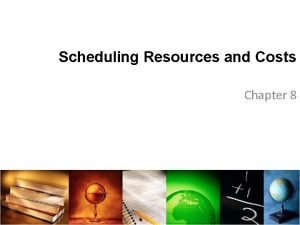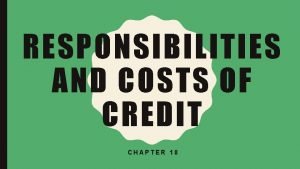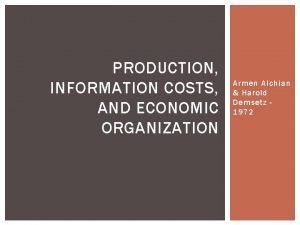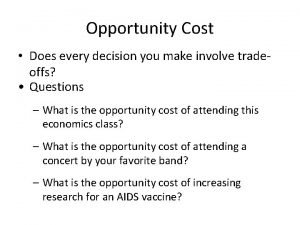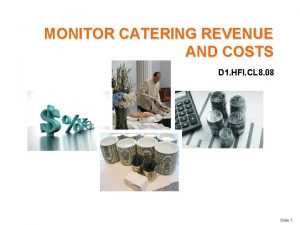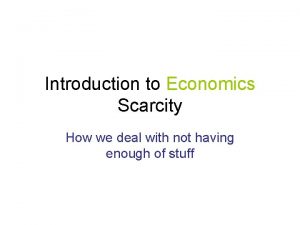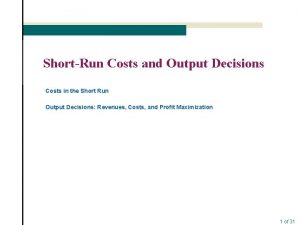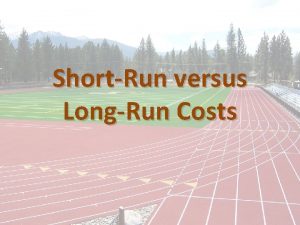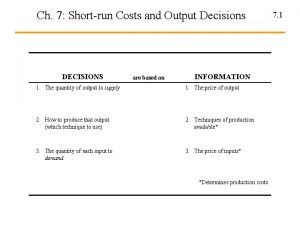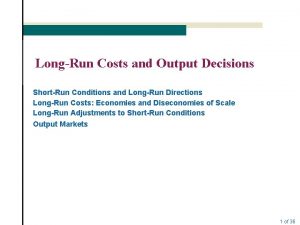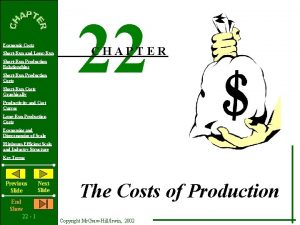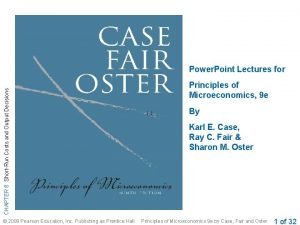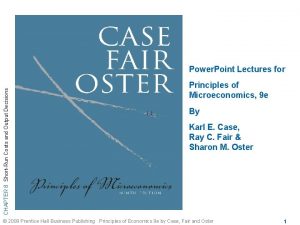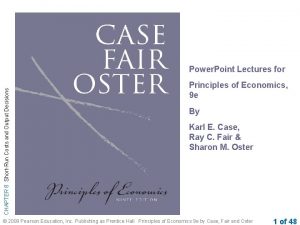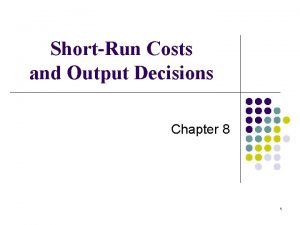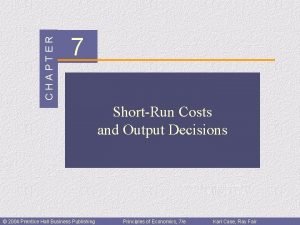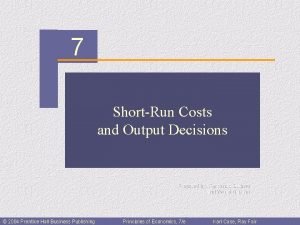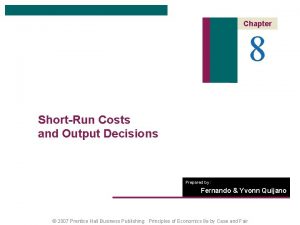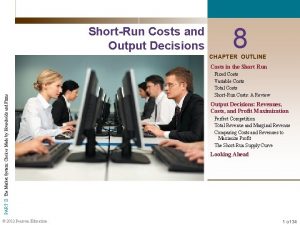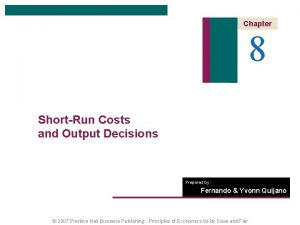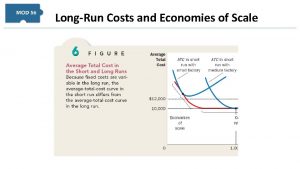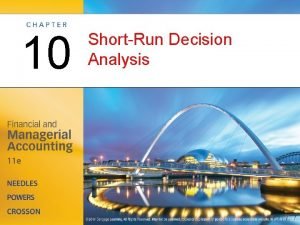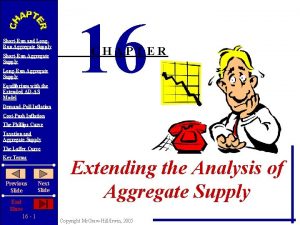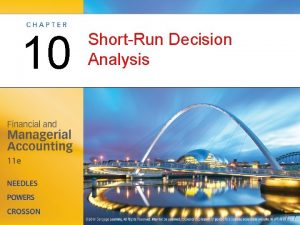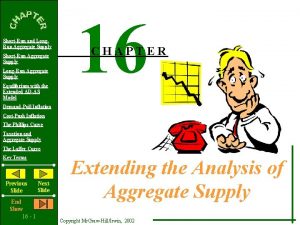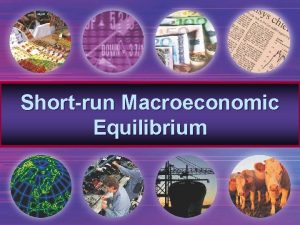ShortRun Costs and Output Decisions 1 Decisions Facing









































- Slides: 41

Short-Run Costs and Output Decisions 1

Decisions Facing Firms DECISIONS are based on INFORMATION 1. How much output to supply The market price of the output 3. How much of each input to demand 2. Which production technology to use 3. 2. The techniques of production that are available The prices of inputs 2

Costs in the Short Run § The short run is a period of time for which two conditions hold: 1. The firm is operating under a fixed scale (fixed factor) of production, and 2. Firms can neither enter nor exit an industry. 3

Costs in the Short Run § Fixed cost is any cost that does not depend on the firm’s level of output. These costs are incurred even if the firm is producing nothing. There are no fixed costs in the long run. § Variable cost is a cost that depends on the level of production chosen. 4

Costs in the Short Run Total Cost = Total Fixed + Total Variable Cost 5

Total Fixed Cost (TFC) § Total fixed costs (TFC) or overhead refers to the total of all costs that do not change with output, even if output is zero. § Another name for fixed costs in the short run is sunk costs is because firms have no choice but to pay for them. 6

Average Fixed Cost (AFC) § Average fixed cost (AFC) is the total fixed cost (TFC) divided by the number of units of output (q): 7

Average Fixed Cost (AFC) • Spreading overhead is the process of dividing total fixed costs by more units of output. Average fixed cost declines as quantity rises. 8

Short-Run Fixed Cost (Total and Average) of a Hypothetical Firm (1) q (2) TFC (3) AFC (TFC/q) 0 $1, 000 $ -- 1 1, 000 2 1, 000 500 3 1, 000 333 4 1, 000 250 5 1, 000 200 9

10

Short-Run Fixed Cost (Total and Average) of a Hypothetical Firm As output increases, total fixed cost § remains constant and average fixed cost declines. 11

Variable Costs § The total variable cost curve is a graph that shows the relationship between total variable cost and the level of a firm’s output. § The total variable cost is derived from production requirements and input prices. 12

Variable Costs 13

Derivation of Total Variable Cost Schedule from Technology and Factor Prices § The total variable cost curve shows the cost of production using the best available technique at each output level, given current factor prices. 14

UNITS OF INPUT REQUIRED (PRODUCTION FUNCTION) PRODUCT USING TECHNIQU E 1 Units of A 4 4 output B 2 6 2 Units of A 7 6 output B 4 10 3 Units of A 9 6 output B 6 14 K L TOTAL VARIABLE COST ASSUMING PK = $2, PL = $1 TVC = (K x PK) + (L x P L) (4 x $2) (4 x $1) = $12 + (2 x $2) (6 x $1) = + (7 x $2) (6 x $1) = $20 $10 + (4 x $2) (10 x $1) + = $18 (9 x $2) (6 x $1) = $24 + (6 x $2) (14 x $1) $26 + = 15

Marginal Cost (MC) Marginal cost (MC) is the increase in total cost § that results from producing one more unit of output. Marginal cost reflects changes in variable costs. UNITS OF OUTPUT 0 1 TOTAL VARIABLE COSTS ($) 0 MARGINAL COSTS ($) 10 0 10 2 18 8 3 24 6 16

The Shape of the Marginal Cost Curve in the Short Run § In the short run every firm is constrained by some fixed input that: 1. leads to diminishing returns to variable inputs, and 2. limits capacity to produce. 17

18

Graphing Total Variable Costs and Marginal Costs § Total variable cost always increases with output. § The marginal cost curve shows how total variable cost changes. 19

20

Average Variable Cost (AVC) Average variable cost (AVC) is the total § variable cost divided by the number of units of output. 21

Average Variable Cost (AVC) • Marginal cost is the cost of one additional unit, while average variable cost is the variable cost per unit of all the units being produced. 22

Short-Run Costs of a Hypothetical Firm 23

(3) MC (D TVC) (4) AVC (TVC/q) (6) TC (TVC + TFC) (7) AFC (TFC/q) 0 $ - $ 1, 00 0 $ 1, 000 $ - 1 10 10 1, 00 0 1, 010 1, 000 2 18 8 9 1, 00 0 1, 018 500 509 3 24 6 8 1, 00 0 1, 024 333 341 4 32 8 8 1, 00 0 1, 032 250 258 5 42 10 8. 4 1, 00 0 1, 042 200 208. 4 - - - - - - 500 8, 00 0 20 1, 00 0 9, 000 (1) q 0 (2) TVC $ 10 16 (5) TFC (8) ATC (TC/q or AFC + AVC) $ 2 1, 010 18 24

Graphing Average Variable Costs and Marginal Costs § When marginal cost is below average cost, average cost is declining. • When marginal cost is above average cost, average cost is increasing. • Marginal cost intersects average variable cost at the lowest , or minimum, point of AVC. 25

• At 200 units of output, AVC is minimum and equal to MC. 26

Total Costs Adding the same § amount of total fixed cost to every level of total variable cost • For this reason, thecost. total yields total cost curve has the same shape as the total variable cost curve; it is simply higher by an amount equal to TFC. 27

Average Total Cost § Average total cost (ATC) is total cost divided by the number of units of output (q). • Because AFC falls with output, an ever-declining amount is added to AVC. 28

Average Total Cost 29

The Relationship Between Average Total Cost and Marginal Cost § If MC is below ATC, then ATC will decline toward marginal cost. § If MC is above ATC, ATC will increase. § MC intersects the ATC and AVC curves at their minimum points. 30

The Relationship Between Average Total Cost and Marginal Cost 31

Output Decisions: Revenues, Costs, and Profit Maximization § The perfectly competitive firm faces a perfectly elastic demand curve for its product. 32

Total Revenue (TR) and Marginal Revenue (MR) § Total revenue (TR) is the total amount that a firm takes in from the sale of its output. 33

Total Revenue (TR) and Marginal Revenue (MR) • Marginal revenue (MR) is the additional revenue that a firm takes in when it increases output by one additional unit. • In perfect competition, P = MR. 34

Comparing Costs and Revenues to Maximize Profit § The profit-maximizing level of output for all firms is the output level where MR = MC. § In perfect competition, MR = P, therefore, the firm will produce up to the point where the price of its output is just equal to short-run marginal cost. § The key idea here is that firms will produce as long as marginal revenue exceeds marginal cost. 35

Comparing Costs and Revenues to Maximize Profit 36

Comparing Costs and Revenues to Maximize Profit § The profit-maximizing output is q*, the point at which P* = MC. 37

Profit Analysis for a Simple Firm (1) q (2) TFC (3) TVC 0 $ 10 10 10 2 10 15 3 10 4 $ 0 (4) MC $ - (5) P = MR $ 15 (6) TR (P x q ) $ (7) (8) TC PROFIT (TFC + TVC) (TR - TC) 0 $ 10 $ -10 15 15 20 -5 5 15 30 25 5 20 5 15 45 30 15 10 30 10 15 60 40 20 5 10 50 20 15 75 60 15 6 10 80 30 15 90 90 0 38

The Short-Run Supply Curve 39

The Short-Run Supply Curve § At any market price, the marginal cost curve shows the output level that maximizes profit. Thus, the marginal cost curve of a perfectly competitive profitmaximizing firm is the firm’s short-run supply curve. 40

Review Terms and Concepts average fixed cost (AFC) average total cost (ATC) average variable cost (AVC) fixed cost marginal cost (MC) marginal revenue (MR) spreading overhead sunk costs total cost (TC) total fixed cost (TFC) total revenue (TR) total variable cost (TVC) total variable cost curve variable cost 41
 Image making meaning
Image making meaning Screening decisions and preference decisions
Screening decisions and preference decisions Pricing and output decisions in perfect competition
Pricing and output decisions in perfect competition Short run cost and output decisions
Short run cost and output decisions Long run cost and output decisions
Long run cost and output decisions Erect position medical terminology
Erect position medical terminology Buttock medical terminology
Buttock medical terminology Political and legal environment facing business
Political and legal environment facing business Yearbook layout design
Yearbook layout design Identifying strategic issues facing the organization
Identifying strategic issues facing the organization Pig personality profile
Pig personality profile What is the guide word
What is the guide word Challenges facing global managers
Challenges facing global managers Facing monsters
Facing monsters Contemporary issues affecting filipino entrepreneurs
Contemporary issues affecting filipino entrepreneurs Chapter 36 moisture control short answers
Chapter 36 moisture control short answers Global sourcing in international business
Global sourcing in international business Palms facing posteriorly
Palms facing posteriorly Fingerprint factoid
Fingerprint factoid What are the challenges facing the church today
What are the challenges facing the church today Abolish high school football
Abolish high school football Economic challenges facing contemporary business
Economic challenges facing contemporary business What is the purpose of facing
What is the purpose of facing Drill drift diagram
Drill drift diagram The head of the virgin in three-quarter view facing right
The head of the virgin in three-quarter view facing right What are the major challenges facing public libraries
What are the major challenges facing public libraries Facing the other way
Facing the other way Game maker shooting in direction character facing
Game maker shooting in direction character facing Challenges facing global managers
Challenges facing global managers Challenges facing family medicine
Challenges facing family medicine The demand curve facing a competitive firm
The demand curve facing a competitive firm Booster seats alberta
Booster seats alberta I am facing south. i turn 90
I am facing south. i turn 90 Standard costs and balanced scorecard
Standard costs and balanced scorecard Scheduling resources and costs
Scheduling resources and costs Trade off and opportunity cost
Trade off and opportunity cost Chapter 18 responsibilities and costs of credit
Chapter 18 responsibilities and costs of credit Production, information costs, and economic organization
Production, information costs, and economic organization Why does every choice involve an opportunity cost
Why does every choice involve an opportunity cost Profit and loss statement
Profit and loss statement Opportunity costs def
Opportunity costs def Embargo definition
Embargo definition


